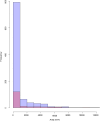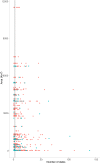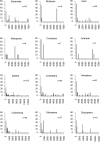Outstanding micro-endemism in New Caledonia: More than one out of ten animal species have a very restricted distribution range
- PMID: 28727847
- PMCID: PMC5519078
- DOI: 10.1371/journal.pone.0181437
Outstanding micro-endemism in New Caledonia: More than one out of ten animal species have a very restricted distribution range
Abstract
New Caledonia is a biodiversity hotspot, with an extremely high number of endemic species with narrow distribution ranges that are at high risk of extinction due to open-cast nickel mining, invasive species and seasonal man-induced fires. Mentions of micro-endemism permeate the literature on the biota of this archipelago. However, so far there has been no research comparing distribution range in different animal groups. The aim of this study is to examine the implication of different sampling effort variables in order to distinguish micro-endemicity from data deficiency, and evaluate the distribution range, frequency, and extent to which micro-endemism is common to several groups of organisms. We compiled a dataset derived from publications in Zoologia Neocaledonica, comprising 1,149 species, of which 86% are endemic to New Caledonia. We found that the sampling effort variables that were best correlated with distribution range were the number of sampling dates and the number of collectors per species. The median value of sampling dates was used to establish a cut-off point for defining adequately sampled species. We showed that, although only 52% of species were sampled adequately enough to determine their distribution range, the number of species with a very narrow distribution range was still high. Among endemics from New Caledonia, 12% (116 species) have ranges ≤5.2km2 and 3.9% (38 species) have ranges between 23 and 100 km2. Surprisingly, a similar trend was observed in non-endemic species: 22% occurred in areas ≤ 5.2 km2, and 8% in areas 23-100 km2, suggesting that environmental dissimilarity may play an important role in the distribution of these species. Micro-endemic species were predominant in 18 out of 20 orders. These results will contribute to a re-assessment of the IUCN red list of species in this archipelago, indicating that at least 116 species are probably critically endangered.
Conflict of interest statement
Figures





References
-
- Rabinowitz D (1981) Seven forms of rarity In: Synge H, editor. The Biological Aspects of Rare Plant Conservation: John Wiley & Sons Ltd; pp. 205–217.
-
- Gaston KJ (1994) Rarity London: Chapman & Hall. 205 p.
-
- Richardson JE, Weitz FM, Fay MF, Cronk QCB, Linder HP, Reeves G, et al. (2001) Rapid and recent origin of species richness in the Cape flora of South Africa. Nature 412: 181–183. doi: 10.1038/35084067 - DOI - PubMed
-
- Wilme L, Goodman SM, Ganzhorn JU. (2006) Biogeographic evolution of Madagascar’s microendemic biota. Science 312: 1063–1065. doi: 10.1126/science.1122806 - DOI - PubMed
-
- Vences M, Wollenberg KC, Vieites DR, Lees DC (2009) Madagascar as a model region of species diversification. Trends in Ecology & Evolution 24: 456–465. - PubMed
MeSH terms
LinkOut - more resources
Full Text Sources
Other Literature Sources
Miscellaneous

